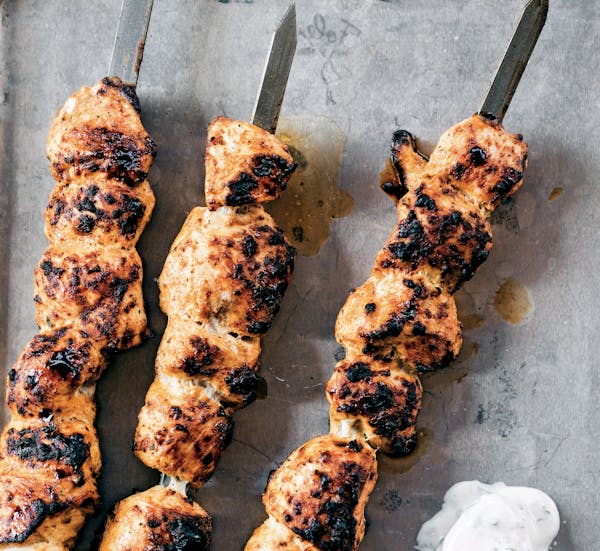An open tin of spices sits before me, wafting a beguiling fragrance of cardamom, allspice, coriander seeds and peppercorns. It's the Se7en Spice blend that Sameh Wadi puts to serious use at his Minneapolis restaurants, Saffron and World Street Kitchen. I could buy the blend at the restaurants — and have in the past — but now the recipe, and more like it, appear in his first cookbook, "The New Mediterranean Table" (Page Street Publishing, 224 pages, $28). These spice blends are tucked into the last chapter, "The Larder," the section that's the heart and soul of his book and his cooking.
It's my favorite part of the book because if there are secrets to Wadi's culinary finesse, these are his, the bold flavors that make his restaurant dishes sing. I'm expecting that mine at home will, too, with a sprinkle of this or that from the book. Garam masala and ras el hanout, charmoula or harissa? Pickled turnips and onions, preserved lemons and caramelized paprika butter? My larder won't be the same. Dinner won't be, either.
Although the "The New Mediterranean Table" is the first to bear Wadi's name, it's not the only cookbook effort for his family. As a child in Kuwait, he watched his family prepare a volume that told the tale of their Palestinian culinary heritage. His parents and uncle collaborated on what they called "The Encyclopedia of Palestinian Cuisine," chronicling the recipes with text and photos.
But before the book could be published, the Gulf War intervened, forcing his family to relocate. The loose pages of the book followed the family through three moves across the world before the family settled in Minnesota in the late '90s. Today Wadi keeps the manuscript near at Saffron, where it serves to connect him to his past and inspire his passion for cooking.
So it's not surprising that his mother is thrilled with the book that bears her son's name. "My mother thinks this is the best thing that has happened in her life. I said, 'What about my being born?' " noted Wadi with a laugh. "And she said, 'Well, since you were born.' "
Over the years, a few gems from the family cookbook had found a home on his restaurant menu, and these favorites have landed within the pages of Wadi's book, including his grandmother's long-cooking green beans and a stuffed eggplant with lamb and pine nuts.
But this is not a "Best of Saffron" cookbook. Wadi wants to make that clear. The title of the book is deliberate, with him writing broadly about the food along the Mediterranean Sea, not exclusive to the Middle East. In fact, he clarifies his intentions by noting in the book's subtitle that his recipes — modern and rustic — span the cooking traditions of three continents.
That includes North Africa. "I'm infatuated with it," he said. "The robust, big, bold flavors with lots of layering. The cuisine fascinates me.
"Unlike the Middle Eastern food that I grew up eating, North African cuisine plays around with sweeter notes," he said. "The cuisine I grew up with has more sour notes. North Africa has a little heat and the sweetness. It has become a part of my language — the new Mediterranean. I'm cooking without too many boundaries."
The prospect of a cookbook was initially a bit of a surprise for him, prompted by a publisher's inquiry. And as all authors find out, the process had its learning curve.
"As a chef at a restaurant, I don't think about things as I do them because I've done them for many years. I don't pay attention to what size pan, or how moderate the heat should be or what caramelize means," he said. "As I wrote the recipes, I realized I needed to change the tone and how I speak. All the recipes were spelled out to try to give people the correct instrument to use and to tell them exactly what heat and what to look for when done."
The stunning photographs, from Matt Lien of Minneapolis, were shot over six months so they were able to tap into the seasonal foods. "A lot of this food is what I crave on a regular basis and what I love to cook and what I wish I could cook more of. That was the inspiration when I wrote the table of contents. I didn't want the book to reflect winter in Minneapolis with all braises and stews," he said.
Wadi considers the recipes to be blueprints for the home cook, and not necessarily to be strictly followed.
"Enjoy the cooking process," he said. "That's what Mediterranean food is all about."
If there's one piece of culinary advice — beyond spices — that Wadi has to offer, it's this, unexpected as it may be:
Use fresh chickpeas, not canned. "It's a whole different animal," he said.
Who knew? The fresh version, grown in California, is in season right now through the end of summer so there is plenty of time to experiment. Chickpeas can be found in Latin, Asian and African markets. Wadi recently sourced some at a Brooklyn Park Asian store. He roasts them whole and sprinkles them with sea salt, to be nibbled like edamame are.
Dried chickpeas are perfectly acceptable, too, as used in the classic recipe for hummus. But stay away from canned. "Too tinny in flavor," he said.
I've been eyeing his recipe for Fresh Chickpeas With Cumin Butter. Now it's time to head to the market.
Follow Lee Svitak Dean on Twitter: @StribTaste.

An NPR editor who wrote a critical essay on the company has resigned after being suspended

